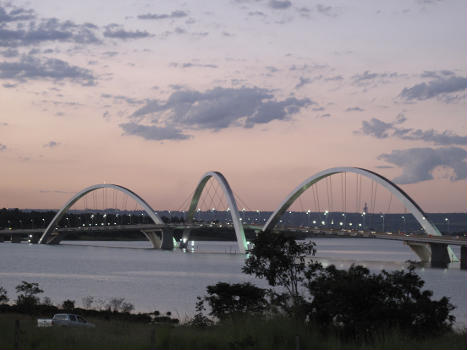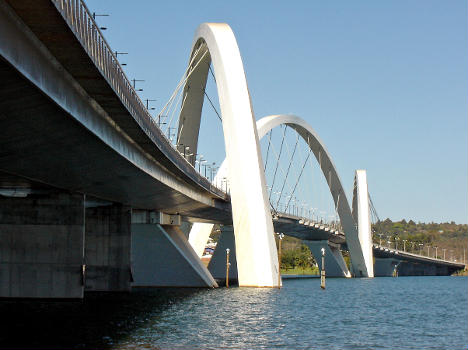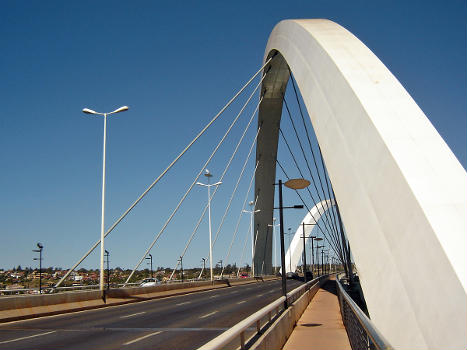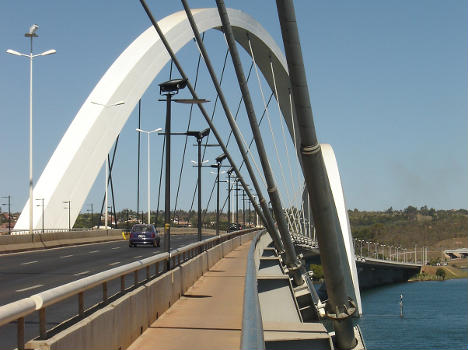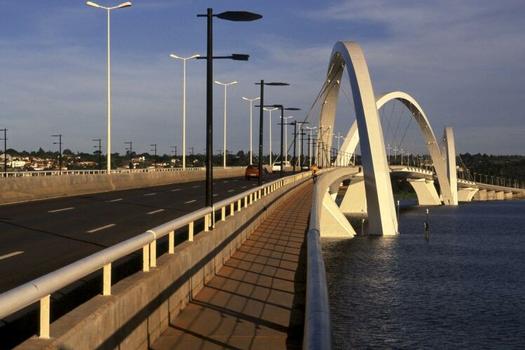General Information
| Name in local language: | Ponte Juscelino Kubitschek |
|---|---|
| Other name(s): | JK Bridge; Mosteiro Bridge; Third Bridge of South Lake |
| Beginning of works: | 2000 |
| Completion: | 2002 |
| Status: | in use |
Project Type
| Structure: |
Through arch bridge |
|---|---|
| Function / usage: |
Motorway bridge / freeway bridge |
| Material: |
Steel bridge |
Location
| Location: |
Brasilia, Distrito Federal, Brazil |
|---|---|
| Crosses: |
|
| Coordinates: | 15° 49' 23.61" S 47° 49' 47.22" W |
Technical Information
Dimensions
| rise | 60 m | |
| total length | 1 200 m | |
| clearance | 18 m | |
| arch span | 3 x 240 m | |
| bridge surface | 28 800 m² | |
| deck | deck width | 24 m |
Materials
| arches |
steel
|
|---|
Chronology
| December 1998 | First Prize in National Contest |
|---|---|
| 1999 | Basic project |
| June 2000 | Service order for construction |
| 2001 | Executive Project. |
| 2003 | Gustav Lindenthal Medal awarded to Alexandre Chan at the International Bridge Conference in Pittsburgh, Pennsylvania, for the design of this bridge. |
| 2003 | Award for best steel structure of the year by ABCEM, Brazil. |
Excerpt from Wikipedia
Juscelino Kubitschek Bridge (Portuguese:Ponte Juscelino Kubitschek), commonly called Ponte JK (English: JK Bridge), is a steel and concrete arch bridge across Lake Paranoá in Brasília, Brazil. It connects the eastern shore of the lake – where Lago Sul, Paranoá and Brasília International Airport are located – to Brasília's city center, via the Monumental Axis. Opened to traffic on December 15, 2002, its distinctive silhouette quickly became a Brasília landmark.
The bridge is named after President Juscelino Kubitschek, who served from 1956 to 1961, and is generally considered the main figure supporting the construction of the planned city of Brasília. It was designed by architect Alexandre Chan and structural engineer Mário Vila Verde.
Description
The bridge structure is 1,200 metres (3,900 ft) long, 24 metres (79 ft) wide and has two three-lane carriageways in each direction and walkways fitted with guard-rails on either for cyclists and pedestrians, each 1.5 metres (4.9 ft) wide, and three 240 metres (790 ft) spans. The main span structure has four supporting pillars standing on the Lake Paranoá lakebed; and the deck weight is supported by three 200-foot-tall (61 m) asymmetrical steel arches that crisscross diagonally. The decks are suspended by steel cables alternating at each side of the deck, interlacing in a twisted plane. The entire structure has a total length of 1,200 metres (3,900 ft), and was completed at a cost of US$56.8 million. The bridge has a pedestrian walkway and is accessible to pedestrians and bicyclists.
Awards
Alexandre Chan received the Gustav Lindenthal Medal for the bridge's project at the 2003 International Bridge Conference in Pittsburgh. This medal is awarded "for a single, recent outstanding achievement showing harmony with the environment, aesthetic merit and successful community participation".
The bridge was also awarded the 2003 Premio Abcem (ABCEM Award) for "Best Steel Work of the Year, Bridges and Highway Overpasses Category", granted by the Brazilian Metal Construction Association (Associação Brasileira da Construção Metálica, ABCEM).
Text imported from Wikipedia article "Juscelino Kubitschek bridge" and modified on July 22, 2019 according to the CC-BY-SA 4.0 International license.
Participants
- Alexandre Chan (designer)
- Mario Vila Verde (structural engineer)
- Beton Engenharia
- COWI AS (arch)
Relevant Web Sites
Relevant Publications
- 3a Ponte. Um sonho que se realiza. In: Brasilia On Line Magazine, v. 4, n. 31, 01/2001.
- (2002): Creating a classic. A sensitive location demanded a special approach to design a new bridge. In: Bridge Design & Engineering, v. 8, n. 29 (4th Quarter 2002).
- Mosteiro Masterpiece. In: Bridge Design & Engineering, v. 5, n. 16 (3rd Quarter 1999), pp. 66.
- A ponte do terceiro milênio. In: Finestra magazine, v. 4, n. 16, 1999..
- (2003): Stählerne Bogenkonstruktion überspannt im Umfeld von Brasilia den Paranoa-See. In: Stahlbau, v. 72, n. 10 (October 2003), pp. 751.
- About this
data sheet - Structure-ID
20000838 - Published on:
20/07/2000 - Last updated on:
28/12/2024

